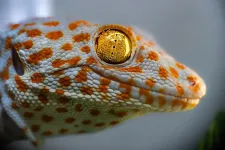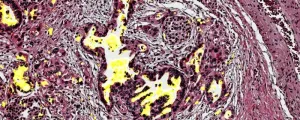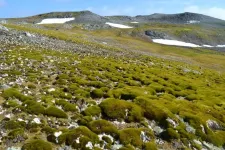Scientists uncover auditory “sixth sense” in geckos
University of Maryland researchers discover that geckos use a mechanism usually associated with balance to sense vibrations, leading to new insights about how animals hear and feel their surroundings.
2024-10-04
(Press-News.org) University of Maryland biologists identified a hidden sensory talent in geckos that’s shaking up what we thought we knew about animal hearing.
In a new study published in Current Biology on October 4, 2024, the researchers revealed that geckos use the saccule—a part of their inner ear traditionally associated with maintaining balance and body positioning—to detect low-frequency vibrations. According to the researchers, this special “sixth sense” also plays a complementary role to the geckos’ normal hearing and the way they sense the world around them. The team believes that this previously unrecognized hearing mechanism may be present in other reptilian species as well, challenging existing ideas about how animal sensory systems evolved and diverged over time.
“The ear, as we know it, hears airborne sound. But this ancient inner pathway, which is typically linked to balance, helps geckos detect vibrations that travel through mediums like the ground or water,” said study co-author Catherine Carr, a Distinguished University Professor of Biology at UMD. “This pathway exists in amphibians and fish, and now it’s proven to be preserved in lizards as well. Our findings shed light on how the auditory system evolved from what you see in fish to what you see in land animals including humans.”
The saccule can detect faint vibrations ranging from 50 and 200 Hz, a spectrum well below what geckos can usually hear through their ears. Researchers say this indicates that the saccule serves a distinct yet complementary function to the geckos’ regular auditory system. While geckos can hear airborne sound, many other reptiles do not have that ability. The study’s lead author Dawei Han, a postdoctoral researcher and former graduate student at UMD, says that the discovery of the saccule’s role in gecko hearing may lead to a better understanding of communication and behavior in other animals previously considered to have limited auditory capabilities.
“A lot of snakes and lizards were thought to be ‘mute’ or ‘deaf’ in the sense that they do not vocalize sounds or hear sounds well,” Han explained. “But it turns out they could potentially be communicating via vibrational signals using this sensory pathway instead, which really changes the way scientists have thought about animal perception overall.”
The existence of this shared sensory pathway in modern reptiles offers a unique window into the evolutionary history of vertebrate sensory systems, suggesting that the transition from aquatic to terrestrial environments likely involved more complex and gradual changes in hearing mechanisms than previously thought.
Although these findings are not directly connected to how humans hear, the researchers believe that there’s always more than meets the eye—or in this case, ear.
“Think about when you’re at a live rock concert,” Carr said. “It’s so loud that you can feel your whole head and body vibrate in the sound field. You can feel the music, rather than just hearing it. That feeling suggests that the human vestibular system may be stimulated during those loud concerts, meaning our sense of hearing and balance may also be linked closely.”
Carr and Han hope their findings will prompt more investigations into mammalian hearing, especially in the context of this sensory pathway. They believe that the established link between hearing and balance opens up new avenues for research, including the connection between human hearing and balance disorders.
“The implications of this research extend beyond the world of reptiles,” Han said. “As we uncover these hidden mechanisms, we’re also gaining a richer and more nuanced picture of how animals perceive and interact with their environments—and potentially, new insights into our own sensory experiences.”
###
The paper, “Auditory pathway for detection of vibration in the tokay gecko,” was published in Current Biology on October 4, 2024
This research was supported by the National Institutes of Health (Grant No. R01DC019341).
END
[Attachments] See images for this press release:

ELSE PRESS RELEASES FROM THIS DATE:
2024-10-04
LONDON, Ont. and REGINA, Sask. – People who inject drugs are dying at an alarming rate from endocarditis, a serious but treatable heart-valve infection.
But their odds of survival improve dramatically, even five years after their first admission to hospital, if they’re treated not just for heart infection but are also provided with addiction support while in hospital, a Canadian study shows.
The study also highlights that women who inject drugs are particularly vulnerable to endocarditis and are affected in disproportionately high numbers.
“Endocarditis is potentially lethal and always costly,” says Dr. Michael Silverman, an infectious ...
2024-10-04
GRAND RAPIDS, Mich. (Sept. 30, 2024) — An experimental blood test detects early-stage pancreatic cancer more effectively than other available tests, reports a new study published in Cancer Letters.
The findings pave the way for further evaluation of the test in a clinical setting, an important step toward approval as a potential diagnostic method for pancreatic cancer.
“Catching pancreatic cancer early dramatically improves survival, but our current tools for doing so are limited,” said the study’s co-corresponding author Brian Haab, Ph.D., a professor at Van Andel Institute. “Our results reveal that our combination ...
2024-10-04
Researchers at Oxford Brookes University have pioneered a groundbreaking method to tackle one of the world’s most persistent environmental threats—toxic chemicals in global water supplies.
They have developed a new machine called a hydrodynamic reactor that uses bubbles which form and collapse due to changes in pressure, a process called cavitation. The reactor removes toxic per- and poly-fluoroalkyl substances (PFAS), also known as “forever chemicals” from water.
PFAS chemicals were invented in the 1930s and used in convenience products ...
2024-10-04
PHILADELPHIA, Oct. 3, 2024 — Jefferson Health has been awarded $2.4 million by the Patient-Centered Outcomes Research Institute (PCORI) to implement evidence-based patient education and coaching programs for weight loss across Jefferson Primary Care.
U.S. adult obesity rates have risen to over 40% in the past two decades, increasing risks of diabetes, heart disease and premature death. Led by Baligh Yehia, M.D., MPP, MSHP, President of Jefferson Health, this project will implement sustainable health education programs ...
2024-10-04
(WASHINGTON – October 4, 2024) In the first study to report real-world outcomes from ciltacabtagene autoleucel (cilta-cel), a chimeric antigen receptor (CAR)-T therapy for multiple myeloma, patients experienced efficacy and safety results similar to those seen in clinical trials, according to results published today in Blood.
Of 236 patients who received cilta-cel infusions at 16 U.S. medical centers in 2022, 89% saw their cancer respond to the treatment and 70% had a complete response, meaning there was no detectable cancer after the treatment. These numbers ...
2024-10-04
A dedicated team of researchers from City University of Hong Kong (CityUHK) is pioneering cutting-edge generative artificial intelligence (GenAI) technologies on a collaborative innovation network platform, aimed at transforming science, technology and innovation (STI) services to empower research and innovation. This innovative project is set to revolutionise the related service delivery by creating a secure GenAI model and digitally transforming processes, thereby facilitating research development and technology innovation, while enhancing data security and service efficiency.
STI services, including ...
2024-10-04
A recent position paper in the Asia-Pacific Journal of Ophthalmology explores the transformative potential of artificial intelligence (AI) in ophthalmology. Led by Lama Al-Aswad, Professor of Ophthalmology and Irene Heinz Given and John La Porte Given Research Professor of Ophthalmology II, of the Scheie Eye Institute, the work represents a collaboration among researchers from Penn Engineering, Penn Medicine, the University of Michigan Kellogg Eye Center, St. John Eye Hospital in Jerusalem, and Gyeongsang National University College of Medicine in Korea.
With fundus photography enabling the visualization ...
2024-10-04
Vegetation cover across the Antarctic Peninsula has increased more than tenfold over the last four decades, new research shows.
The Antarctic Peninsula, like many polar regions, is warming faster than the global average, with extreme heat events in Antarctica becoming more common.
The new study – by the universities of Exeter and Hertfordshire, and the British Antarctic Survey – used satellite data to assess how much the Antarctic Peninsula has been “greening” in response to climate change.
It found that the area of vegetation ...
2024-10-04
Every second, more than 3,000 stars are born in the visible universe. Many are surrounded by what astronomers call a protoplanetary disk – a swirling "pancake" of hot gas and dust from which planets form. The exact processes that give rise to stars and planetary systems, however, are still poorly understood.
A team of astronomers led by University of Arizona researchers has used NASA's James Webb Space Telescope to obtain some of the most detailed insights into the forces that shape protoplanetary disks. The observations offer glimpses into what our solar system may have looked like 4.6 billion years ago.
Specifically, the team was able to trace so-called ...
2024-10-04
Black and Hispanic faculty members seeking promotion at research universities face career-damaging biases, with their scholarly production judged more harshly than that of their peers, according to a groundbreaking initiative co-led by the University of California, Merced that aims to uncover the roots of these biases and develop strategies for change.
Junior professors are generally evaluated and voted on for promotion and tenure by committees comprising senior colleagues. In one of the studies conducted by the research team, results suggest that faculty from underrepresented minorities received 7% more negative votes from ...
LAST 30 PRESS RELEASES:
[Press-News.org] Scientists uncover auditory “sixth sense” in geckos
University of Maryland researchers discover that geckos use a mechanism usually associated with balance to sense vibrations, leading to new insights about how animals hear and feel their surroundings.




